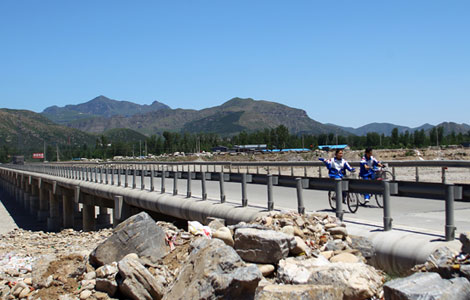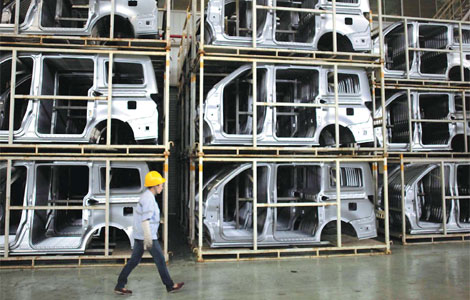Talent and instinct
Updated: 2013-06-14 10:01
By Zhang Zixuan (China Daily)
|
|||||||||||
 |
|
Mao Yan presents his first solo exhibition at Pace Gallery at 798 Art Zone in Beijing. Zhang Zixuan / China Daily |
A star of China's contemporary art world, painter Mao Yan says his work doesn't reflect his favorite old masters but his own state of mind. Zhang Zixuan reports.
With center-parted short hair and baggy old jeans, 45-year-old Mao Yan looks more like a rebellious youth with the bearing of a sharp and sensitive artist.
The vanguard painter is said to be the most difficult to define among today's Chinese art icons. His brushworks are extremely contemporary, though the artist claims to have a serious classicism complex.
He has stayed in Nanjing for years, while other artists proceeded northward, flocking to the capital.
Despite the multifaceted symbols and concepts emerging in the endless stream of contemporary Chinese art, he sticks to portraits, the most traditional subject of easel painting that has gradually been pushed aside by newer art forms.
"Painting to me is an instinct," Mao says. "I don't like doing things 'on purpose', and I have no need to prove myself just for a trend or an idea."
At Pace Gallery in Beijing, Mao is presenting his first solo exhibition after signing with the gallery.
Featured works include several pieces from his best-known Thomas Series from the late 1990s and a few unconventional portraits of animals. Two large-scale portraits of naked women painted this year are the artist's first-ever showing of this kind.
Mao was named the most influential oil painter of 2012 at the 7th Award of Art China in May. He along with three other artists will also be announced as the 2013 Martell Artists of the Year in mid-June.
"I heard many fellow artists highly praise Mao's superb technique. But what is most precious is his earnestness in work, which is like a mirror that shames those pretenders," comments artist Li Xiaoshan.
Studying painting with his father since the age of 3, Mao quickly showed his precocious ability and was labeled a "genius" even before he entered the Central Academy of Fine Arts in 1988. In 1992 the then 24-year-old achieved national fame at the 1990s Art Biennale held in Guangzhou for his work Portrait of Xiaoshan.
He continued to portray his friends until the late 1990s when he met Thomas, an overseas student from Luxemburg. For the next decade, Thomas was the only subject on Mao's canvas.
"Subjects depicted during Mao's 'pre-Thomas period' had faint social identities, age characters and completed postures; later, these elements were simplified yet the personality became stronger," comments writer Han Dong.
"Thomas is only a cover; it could be anybody including myself," says Mao, who intended to escape from the booming cluster of Chinese symbols at that time by portraying a foreigner.
These finished portraits are therefore a far cry from the original model. "There are surely resemblances in appearance and character, but I endow the figures with extra features through the eyes and facial expression, and through the tone," Mao says.
Mao also likes to infuse instant feelings into every stroke of the brush. For example, if he is obsessed with Song Dynasty (960-1279) poetry during a certain period of time, his inspired sentiment will be reflected in the following works.
Since the mid-1990s, colors of flame and warm brown in his works have gradually been covered and replaced by a much calmer tone of gray, which has lasted till today.
He brushes each canvas with multiple thin layers, which creates a progressive visual that prints fail to capture. But such a method of painting slows down the process and limits him to a few pieces per year. "Every piece deserves years of efforts," believes Mao, stressing that even this must be after "good communication with the model" - otherwise the process "is very likely to continue infinitely".
His pursuit of perfection has been corroborated by the market. In 2007 Mao ascended the million-dollar club when his oil painting Memory or Dancing Black Rose fetched 10.01 million yuan ($1.63 million) at the Beijing Poly Spring Auction.
And in 2011, Mao's Portrait of Xiaoka sold for 12.65 million yuan at the Beijing Poly Autumn Auction, setting his highest record at an auction house.
Aside from the Thomas series that will continue, Mao says, he is preparing a new portrait project studying the images of Chinese people. That, he says, "will be a lifetime project".
"I enjoy spending a long time doing one thing without giving much thought to its meaning or result," he says. "It is my painting principle as well as my attitude toward life."
Related Stories
Chinese artist exhibits Tibetan mastiff paintings in St. Petersburg 2013-06-07 09:32
Liu Yong's paintings to be auctioned in Beijing 2013-06-05 14:54
Paintings reflect artist's exploration about social changes 2013-06-03 17:25
Exhibition of Meneghetti's paintings kicks off in Wuhan 2013-05-31 16:34
Richter painting breaks record for living artist at N.Y. auction 2013-05-16 16:08
Today's Top News
China gives approval to GM soybeans
EU files WTO dispute on steel measures
EU seeks WTO ruling over steel measures
Nation's rise a common goal across Straits
Astronauts into space module
Li urges further Ethiopian ties
US should 'explain hacking activity'
Chinese continue leaving Ghana
Hot Topics
Lunar probe , China growth forecasts, Emission rules get tougher, China seen through 'colored lens', International board,
Editor's Picks

|

|

|

|

|

|







